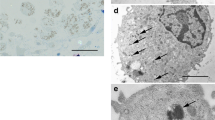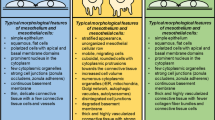Abstract
Objective and design
During peritonitis, mesothelial cells assume macrophage characteristics, expressing macrophage markers, indicating that they might differentiate into macrophage-like cells.
Materials and subjects
Twenty-five male rats were used for in vivo experiments. For in vitro experiments, a primary mesentery culture model was developed. The mesothelial cell to macrophage-like cell transition was followed by studying ED1 expression.
Treatments
In vitro primary mesenteric culture was treated with granulocyte–macrophage colony-stimulating factor (GM-CSF, 1 ng/ml). Blocking internalization of receptor–ligand complex, Dynasore (80 µM) was used. Acute peritonitis was induced by Freund’s adjuvant’s (1 ml) intraperitoneal injection.
Results
Immunohistochemistry: GM-CSF in vitro treatment resulted in a prominent ED1 expression in transformed mesothelial cells. Blocking the internalization, ED1 expression could not be detected. GM-CSF receptor (both α and β) was expressed in mesothelial cells in vitro (even if the GM-CSF was not present) and in vivo. Inflammation resulted in an increasing GM-CSF and GM-CSF-receptor level in the lysate of mesothelial cells.
Conclusions
Mesothelial cells can differentiate into macrophage-like cells, and GM-CSF, produced by the mesothelial cells, has probably an autocrine regulatory role in this transition. Our results provide new data about the plasticity of mesothelial cell and support the idea that during inflammation macrophages can derive from non-hematopoietic sources as well.








Similar content being viewed by others
References
van Furth R, Cohn ZA, Hirsch JG, Humphry JH, Spector WG, Lange-Woort HL. Mononuclear phagocytic system: new classification of macrophages, monocytes and their cell line. Bull World Health Organ. 1972;47:651–8.
Geissmann F, Manz MG, Jung S, Siewehe MH, Merad M, Ley K. Development of monocytes, macrophages and dendritic cells. Science. 2010;327:656–61.
Ginsel LA, Rijfkogel LP, Daems WT. A dual origin of macrophages? Review and hypothesis. In: Reichard S, Kojima M, editors. Macrophage biology. New York: Alan R. Liss; 1985. p. 621–49.
De Bakker JM, de Wit AW, Woelders H, Ginsel LA, Deams WT. On the origin of peritoneal resident macrophages. II. Recovery of the resident macrophage population in the peritoneal cavity and milky spots after peritoneal cell depletion. J Submicrosc Cytol. 1985;7:141–51.
Papadimitriou JM, Ashman RB. Macrophages: current view on their differentiation, structure and function. Ultrastruct Pathol. 1989;13:343–72.
Kiss AL, Kittel A. Early endocytotic steps in elicited macrophages: omega-shaped plasma membrane vesicles at their cell surface. Cell Biol Int. 1995;19:527–38.
Katz S, Balogh P, Nagy N, Kiss AL. Epithelial-to-mesenchymal transition induced by Freund’s adjuvant treatment in rat mesothelial cells: a morphological and immunocytochemical study. Pathol Oncol Res. 2012;18:641–9.
Rasko JEJ, Grough MM. Granulocyte macrophage-colony stimulating factor. In: Thompson AW, editor. Cytokine handbook. 2 ed. New York: Academic Press; 1994. p. 342–69.
Gasson JC, Weisbart RH, Kaufman SE, Clark SC, Hewich RM, Wong GG, Golde DW. Purified human GM-colony stimulating factor: direct action on neutrophils. Science. 1984;226:1339–42.
Kupper TS, Lee F, Birchall N, Clark S, Dower S. Interleukin-1 binds to specific receptors on keratinocytes and induces granulocyte/macrophage colony stimulating factor mRNA and protein. A potential autocrine role for IL-1 in epidermis. J Clin Investig. 1988;82:1787–92.
Metcalf D, Begley CG, Johnson GR, Nicola NA, Vadas MA, Lopez AF, Williamson DJ, Wong GG, Clark SC, Wang EA. Biologic properties in vitro of a recombinant human granulocyte–macrophage colony-stimulating factor. Blood. 1986;67:37–45.
Martinez-Moczygemba M, Huston DP. Biology of common beta receptor-signaling cytokines: IL-3, IL-5 and GM-CSF. J Allergy Clin Immunol. 2003;112:653–65.
Liou W, Geuze HJ, Slot JW. Improving structural integrity of cryosections for immunogold labeling. Histochem Cell Biol. 1996;106:41–58.
Bradford MM. A rapid and sensitive method for the quantitation of microgram quantities of protein utilizing the principle of protein–dye binding. Anal Biochem. 1976;72:248–54.
Fletcher SJ, Poulter NS, Haining EJ, Rappoport JZ. Clathrin-mediated endocytosis regulates occluding, and not focal adhesion, distribution during epithelial wound healing. Biol Cell. 2012;104:238–56.
Katz S, Balogh P, Kiss AL. Mesothelial cells can detach from the mesentery and differentiate into macrophage-like cells. APMIS. 2011;119:782–93.
Hamilton LA. GM-CSF in inflammation and autoimmunity. Trends Immunol. 2002;23:403–8.
Fleetwood AJ, Cook AD, Hamilton JA. Functions of granulocyte–macrophage colony-stimulating factor. Crit Rev Immunol. 2005;25:405–28.
Fukuzawa H, Sawada M, Kayahara T, Morita-Fujisawa Y, Suzuki K, Seno H, Takaishi S, Chiba T. Identification of GM-CSF in Paneth cells using single-cell RT-PCR. Biochem Biophys Res Commun. 2003;312:897–902.
Hamilton JA. Colony-stimulating factors in inflammation and autoimmunity. Nat Rev Immunol. 2008;8:533–44.
Hayashida K, Kitamura T, Gorman DM, Arai K, Yokota T, Miyajima A. Molecular cloning of a second subunit of the receptor for human granulocyte–macrophage colony-stimulating factor (GM-CSF): reconstitution of a high-affinity GM-CSF receptor. Proc Natl Acad Sci. 1990;87:9655–9.
Park LS, Friend D, Gills S, Urdal DL. Characterization of the cell surface receptor for human granulocyte/macrophage colony-stimulating factor. J Exp Med. 1986;164:251–62.
Griffin JD, Cannistra SA, Sullivan R, Demetri GD, Ernst TJ, Kanakura Y. The biology of GM-CSF: regulation of production and interaction with its receptor. Int J Cell Cloning. 1990;8:35–44.
Bussolino F, Colotta F, Bocchietto E, Guglielmetti A, Mantovani A. Recent developments in the cell biology of granulocyte–macrophage colony-stimulating factor and granulocyte colony-stimulating factor: activities on endothelial cells. Int J Clin Lab Res. 1993;23:8–12.
Panja A, Goldberg S, Eckmann L, Krishen P, Mayer L. The regulation and functional consequence of proinflammatory cytokine binding on human intestinal epithelial cells. J Immunol. 1998;161:3675–84.
Egea L, Hirata Y, Kagnoff MF. GM-CSF: a role in immune and inflammatory reactions in intestine. Expert Rev Gastroenterol Hepatol. 2010;4:723–31.
Zhao Y, Chegini N. Human fallopian tube expresses granulocyte–macrophage colony stimulating factor (GM-CSF) and GM-CSF alpha and beta receptors and contain the immunoreactive GM-CSF protein. J Clin Endocrinol Metab. 1994;79:662–5.
Zhao Y, Chegini N. The expression of granulocyte macrophage-colony stimulating factor (GM-CSF) and receptors in human endometrium. Am J Reprod Immunol. 1999;42:303–11.
Robertson SA, Seamark RF, Guilbert LJ, Wegmann TG. The role of cytokines in gestation. Crit Rev Immunol. 1994;14:239–92.
Balogh P, Szabó A, Katz S, Likó I, Patócs A, Kiss AL. Estrogen receptor alpha is expressed in mesenteric mesothelial cells and is internalized in caveolae upon Freund’s adjuvant treatment. PLoS One. 2013;8. doi:10.1371/journal.pone.0079508.
Corda D, Hidalgo Carcedo C, Bonazzi M, Luini A, Spano S. Molecular aspects of membrane fission in the secretory pathway. Cell Mol Life Sci. 2002;59:1819–32.
Nichols B. Caveosomes and endocytosis of lipid rafts. J Cell Sci. 2003;116:4707–14.
Takei K, Yoshida Y, Yamada H. Regulatory mechanisms of dynamin-dependent endocytosis. J Biochem. 2005;137:243–7.
Acknowledgments
We would like to express our thankfulness to Professor Pál Röhlich for the precious comments and accurate language correction of the manuscript. Our special thanks go to Katalin Lőcsey for her valuable technical help.
Author information
Authors and Affiliations
Corresponding author
Ethics declarations
Conflict of interest
The authors declare that they have no conflict of interest.
Ethical approval
All applicable international, national, and/or institutional guidelines for the care and use of animals were followed.
Additional information
Responsible Editor: John Di Battista.
Rights and permissions
About this article
Cite this article
Katz, S., Zsiros, V., Dóczi, N. et al. GM-CSF and GM-CSF receptor have regulatory role in transforming rat mesenteric mesothelial cells into macrophage-like cells. Inflamm. Res. 65, 827–836 (2016). https://doi.org/10.1007/s00011-016-0967-5
Received:
Revised:
Accepted:
Published:
Issue Date:
DOI: https://doi.org/10.1007/s00011-016-0967-5




